April 11, 2014 at 2:55 pm
[caption id="attachment_1089" align="alignleft" width="300"]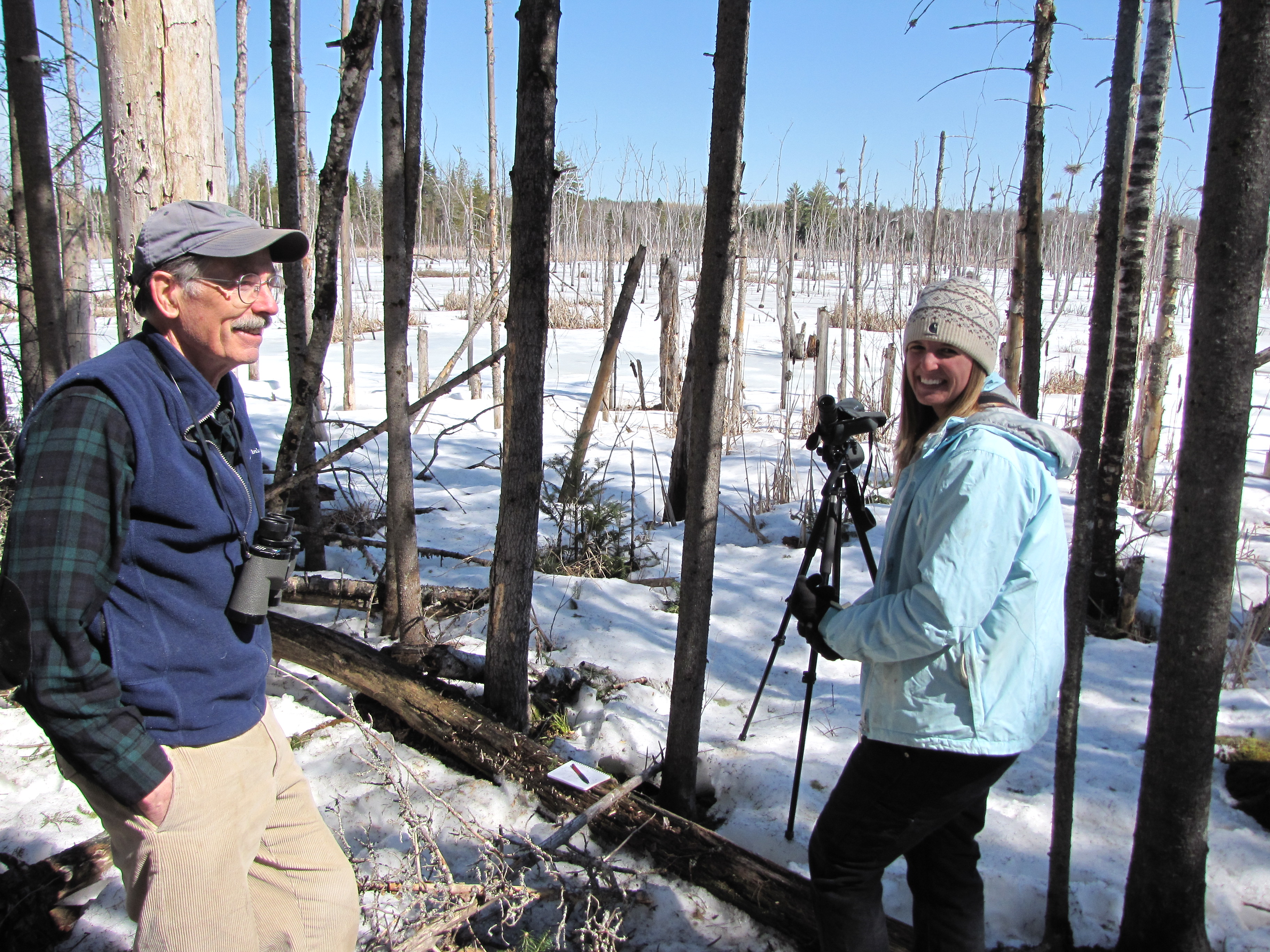 Volunteer, Rick Lawrence and technician, Brittany Currier, making observations from the wetland edge.[/caption]
This Thursday, I had the pleasure of going out in the field with volunteer, Rick Lawrence, and technician, Brittany Currier. This was my first heron colony visit of the season and it was a rewarding one. Despite post-holing through snow to get to the colony wetland, the day was relatively warm and more importantly, sunny! When we reached the colony edge, I immediately noticed one adult great blue heron standing on one of the nests, and a second flying off in the background.
[caption id="attachment_1091" align="alignright" width="225"]
Volunteer, Rick Lawrence and technician, Brittany Currier, making observations from the wetland edge.[/caption]
This Thursday, I had the pleasure of going out in the field with volunteer, Rick Lawrence, and technician, Brittany Currier. This was my first heron colony visit of the season and it was a rewarding one. Despite post-holing through snow to get to the colony wetland, the day was relatively warm and more importantly, sunny! When we reached the colony edge, I immediately noticed one adult great blue heron standing on one of the nests, and a second flying off in the background.
[caption id="attachment_1091" align="alignright" width="225"]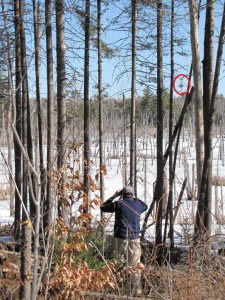 Volunteer, Rick Lawrence scanning the colony. One great blue heron was observed and is circled in red in this photo.[/caption]
I quickly got a photo of the adult in the nest; it was a good thing I did because it soon flew off out of view.
[caption id="attachment_1090" align="aligncenter" width="300"]
Volunteer, Rick Lawrence scanning the colony. One great blue heron was observed and is circled in red in this photo.[/caption]
I quickly got a photo of the adult in the nest; it was a good thing I did because it soon flew off out of view.
[caption id="attachment_1090" align="aligncenter" width="300"]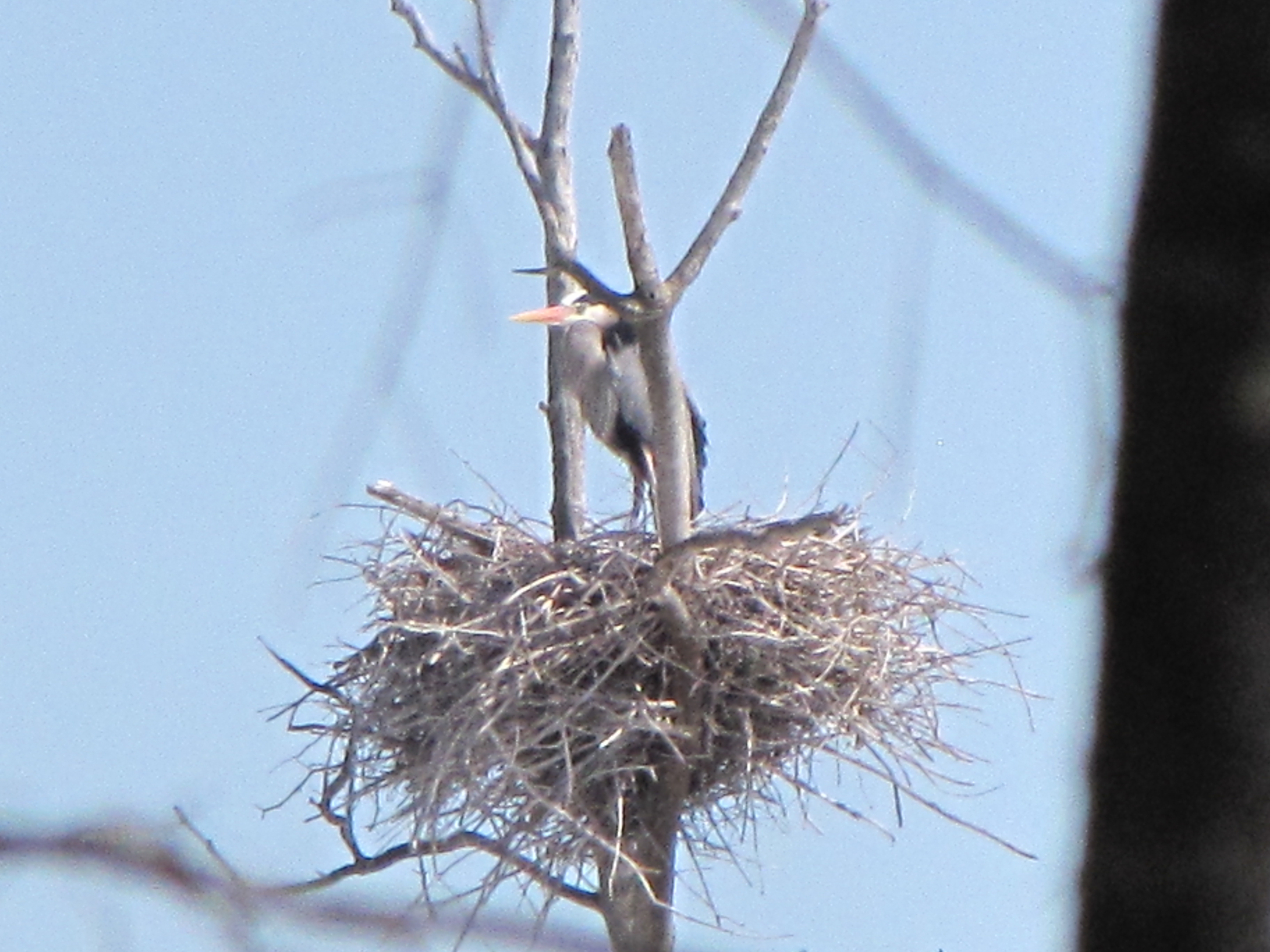 Adult great blue heron at nest (had to zoom in a lot, here!).[/caption]
This colony is one of our largest inland sites: we counted 42 old nests from last year. Some survived the winter well and even looked as though they might have been fixed up a bit already, but there were also many that had considerably fallen apart.
Adult great blue heron at nest (had to zoom in a lot, here!).[/caption]
This colony is one of our largest inland sites: we counted 42 old nests from last year. Some survived the winter well and even looked as though they might have been fixed up a bit already, but there were also many that had considerably fallen apart.
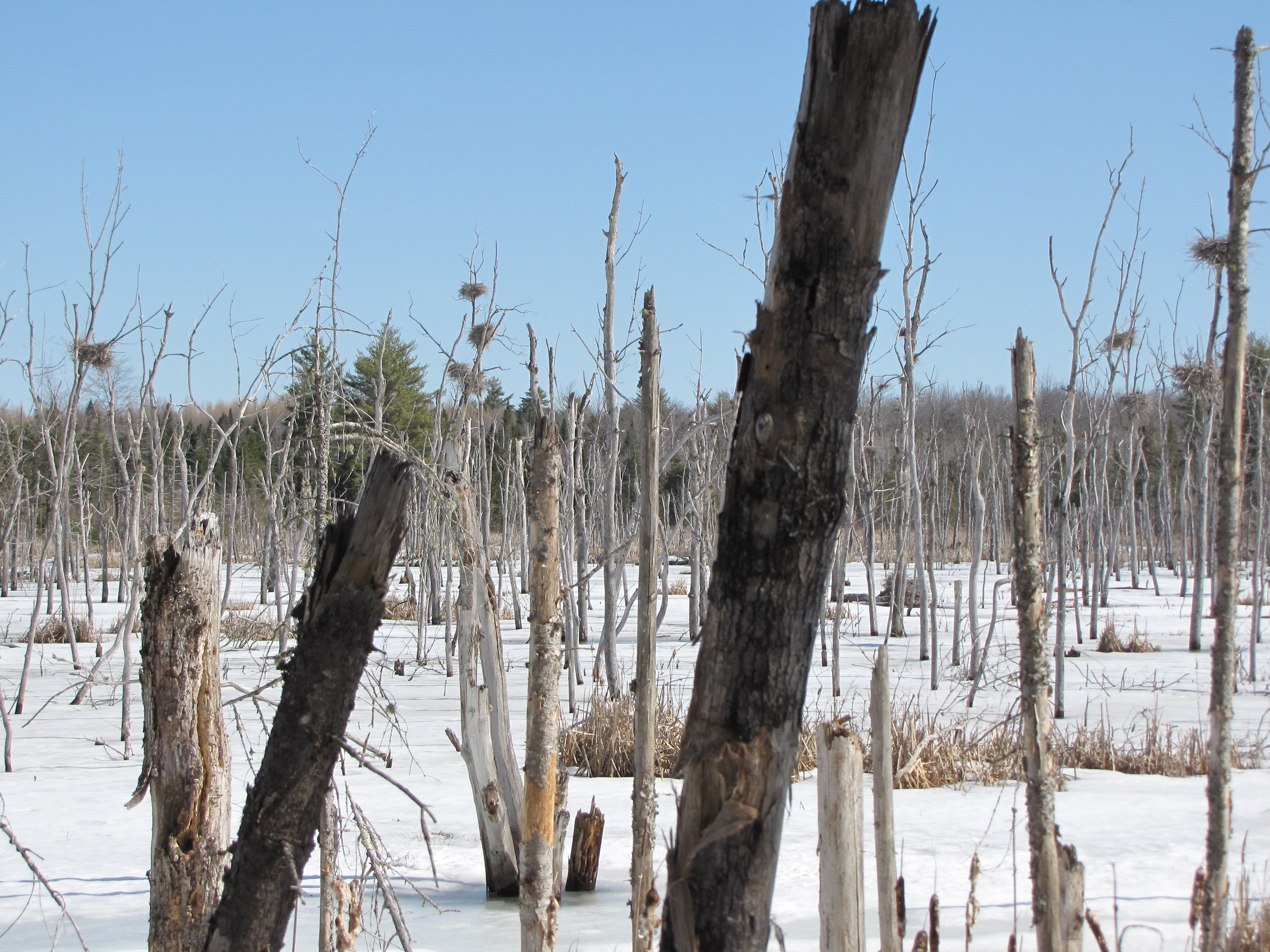 We took our time at the colony edge, trying to get glimpses of other spring arrivals. A pair of Canada geese flew in and landed on the still-frozen wetland. Spring seems to be taking its time this year, but the birds are arriving on time and seem poised and ready for the nesting season. Tree swallows, red-winged blackbirds, and common grackles could be heard or seen from various corners of the wetland.
[caption id="attachment_1092" align="alignleft" width="300"]
We took our time at the colony edge, trying to get glimpses of other spring arrivals. A pair of Canada geese flew in and landed on the still-frozen wetland. Spring seems to be taking its time this year, but the birds are arriving on time and seem poised and ready for the nesting season. Tree swallows, red-winged blackbirds, and common grackles could be heard or seen from various corners of the wetland.
[caption id="attachment_1092" align="alignleft" width="300"]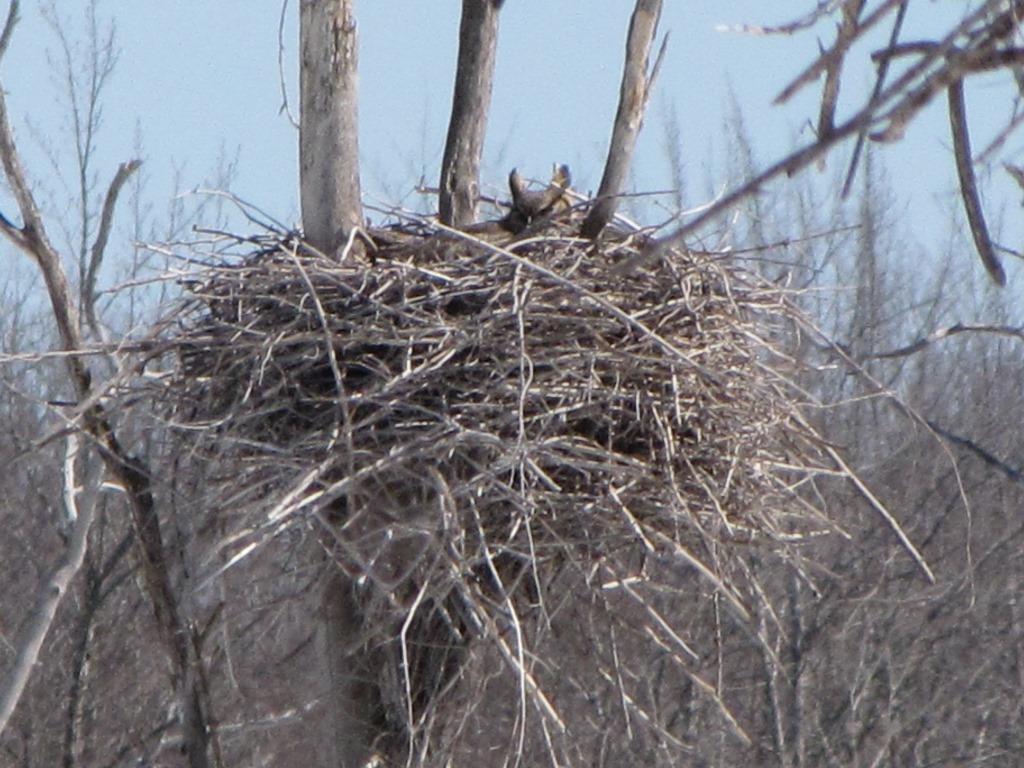 Great horned owl in old heron nest.[/caption]
The most interesting find of the day was a great horned owl occupying one of the heron nests from last year! It was sitting low as if incubating eggs, thus we did't notice it until we started looking at each nest individually. The soft brown ear tufts waving in the wind above the nest's rim gave it away. This is the second time I have witnessed a great horned owl using a heron nest. The last one I observed was on April 25, 2012 and the owl had at least 1 fuzzy chick at that time. In that same nest tree were 4 active heron nests! This time the herons have barely gotten started nesting, so it will be interesting to see if the herons mind the presence of a formidable predator. Even if the owl's eggs hatched yesterday, the young owlets would remain in the nest and be fed by the adults for at least 60 days, or well into June. Needless to say, we will be watching this colony closely to see how the two species get along!
Great horned owl in old heron nest.[/caption]
The most interesting find of the day was a great horned owl occupying one of the heron nests from last year! It was sitting low as if incubating eggs, thus we did't notice it until we started looking at each nest individually. The soft brown ear tufts waving in the wind above the nest's rim gave it away. This is the second time I have witnessed a great horned owl using a heron nest. The last one I observed was on April 25, 2012 and the owl had at least 1 fuzzy chick at that time. In that same nest tree were 4 active heron nests! This time the herons have barely gotten started nesting, so it will be interesting to see if the herons mind the presence of a formidable predator. Even if the owl's eggs hatched yesterday, the young owlets would remain in the nest and be fed by the adults for at least 60 days, or well into June. Needless to say, we will be watching this colony closely to see how the two species get along!
 Volunteer, Rick Lawrence and technician, Brittany Currier, making observations from the wetland edge.[/caption]
This Thursday, I had the pleasure of going out in the field with volunteer, Rick Lawrence, and technician, Brittany Currier. This was my first heron colony visit of the season and it was a rewarding one. Despite post-holing through snow to get to the colony wetland, the day was relatively warm and more importantly, sunny! When we reached the colony edge, I immediately noticed one adult great blue heron standing on one of the nests, and a second flying off in the background.
[caption id="attachment_1091" align="alignright" width="225"]
Volunteer, Rick Lawrence and technician, Brittany Currier, making observations from the wetland edge.[/caption]
This Thursday, I had the pleasure of going out in the field with volunteer, Rick Lawrence, and technician, Brittany Currier. This was my first heron colony visit of the season and it was a rewarding one. Despite post-holing through snow to get to the colony wetland, the day was relatively warm and more importantly, sunny! When we reached the colony edge, I immediately noticed one adult great blue heron standing on one of the nests, and a second flying off in the background.
[caption id="attachment_1091" align="alignright" width="225"] Volunteer, Rick Lawrence scanning the colony. One great blue heron was observed and is circled in red in this photo.[/caption]
I quickly got a photo of the adult in the nest; it was a good thing I did because it soon flew off out of view.
[caption id="attachment_1090" align="aligncenter" width="300"]
Volunteer, Rick Lawrence scanning the colony. One great blue heron was observed and is circled in red in this photo.[/caption]
I quickly got a photo of the adult in the nest; it was a good thing I did because it soon flew off out of view.
[caption id="attachment_1090" align="aligncenter" width="300"] Adult great blue heron at nest (had to zoom in a lot, here!).[/caption]
This colony is one of our largest inland sites: we counted 42 old nests from last year. Some survived the winter well and even looked as though they might have been fixed up a bit already, but there were also many that had considerably fallen apart.
Adult great blue heron at nest (had to zoom in a lot, here!).[/caption]
This colony is one of our largest inland sites: we counted 42 old nests from last year. Some survived the winter well and even looked as though they might have been fixed up a bit already, but there were also many that had considerably fallen apart.
 We took our time at the colony edge, trying to get glimpses of other spring arrivals. A pair of Canada geese flew in and landed on the still-frozen wetland. Spring seems to be taking its time this year, but the birds are arriving on time and seem poised and ready for the nesting season. Tree swallows, red-winged blackbirds, and common grackles could be heard or seen from various corners of the wetland.
[caption id="attachment_1092" align="alignleft" width="300"]
We took our time at the colony edge, trying to get glimpses of other spring arrivals. A pair of Canada geese flew in and landed on the still-frozen wetland. Spring seems to be taking its time this year, but the birds are arriving on time and seem poised and ready for the nesting season. Tree swallows, red-winged blackbirds, and common grackles could be heard or seen from various corners of the wetland.
[caption id="attachment_1092" align="alignleft" width="300"] Great horned owl in old heron nest.[/caption]
The most interesting find of the day was a great horned owl occupying one of the heron nests from last year! It was sitting low as if incubating eggs, thus we did't notice it until we started looking at each nest individually. The soft brown ear tufts waving in the wind above the nest's rim gave it away. This is the second time I have witnessed a great horned owl using a heron nest. The last one I observed was on April 25, 2012 and the owl had at least 1 fuzzy chick at that time. In that same nest tree were 4 active heron nests! This time the herons have barely gotten started nesting, so it will be interesting to see if the herons mind the presence of a formidable predator. Even if the owl's eggs hatched yesterday, the young owlets would remain in the nest and be fed by the adults for at least 60 days, or well into June. Needless to say, we will be watching this colony closely to see how the two species get along!
Great horned owl in old heron nest.[/caption]
The most interesting find of the day was a great horned owl occupying one of the heron nests from last year! It was sitting low as if incubating eggs, thus we did't notice it until we started looking at each nest individually. The soft brown ear tufts waving in the wind above the nest's rim gave it away. This is the second time I have witnessed a great horned owl using a heron nest. The last one I observed was on April 25, 2012 and the owl had at least 1 fuzzy chick at that time. In that same nest tree were 4 active heron nests! This time the herons have barely gotten started nesting, so it will be interesting to see if the herons mind the presence of a formidable predator. Even if the owl's eggs hatched yesterday, the young owlets would remain in the nest and be fed by the adults for at least 60 days, or well into June. Needless to say, we will be watching this colony closely to see how the two species get along!Categories